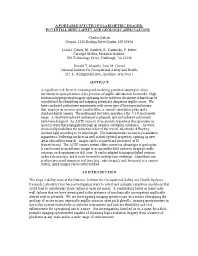Mining Publication: A Portable Spectro-Polarimetric Imager: Potential Mine Safety and Geologic Applications
Original creation date: March 1999
A significant risk factor in assessing and modeling potential catastrophic slope movement in open-pit mines is the presence of argillic alteration in host rocks. High-resolution hyperspectral imagery operating in the visible to shortwave infrared can be a useful tool for identifying and mapping potentially dangerous argillic zones. We have conducted preliminary experiments with a new type of hyperspectral imager that employs an acousto-optic tunable filter, a variable retardation plate and a standard digital camera. The instrument we tested operates in the .5-1.0 micrometer range. A shortwave infrared instrument is planned, and mid-infrared instruments have been designed. An AOTF consists of an acoustic transducer that generates an acoustic wave that propagates through an attached crystalline substance. The wave sinusoidally modulates the refractive index of the crystal, selectively diffracting incident light according to its wavelength. The instrument also measures polarization signatures of reflecting surfaces as well as their spectral properties, opening up new areas of possible research. Images can he acquired and processed at 30 frames/second. The AOTF camera system offers numerous advantages to geologists. It can be used as an airborne imager or as a portable field device to image pit walls, outcrops, rock specimens or drill core. It can be adapted to image polished sections under a microscope, and it could be used in underground workings. Algorithms can produce processed images in real time (e.g., ratio images), and, because it is a camera system, aerial images can be orthorectified.
Authors: C Sabine, LJ Denes, M Gottlieb, B Kaminsky, P Metes, RT Mayerle, JM Girard
Conference Paper - March 1999
Proceedings of the Thirteenth International Conference, Applied Geologic Remote Sensing, Vancouver, British Columbia, Canada, 1-3 March 1999; 1:I190-I194
See Also
- Advances in Remote Sensing Techniques for Monitoring Rock Falls and Slope Failures
- Analysis of Bench Crest Performance at the Yellowstone Mine: A Case Study
- Applications of Ground-Based Radar to Mine Slope Monitoring
- Assessing and Monitoring Open Pit Mine Highwalls
- Continuous Wave Laser Ignition Thresholds of Coal Dust Clouds
- Material Properties Affecting the Stability of a 50-Year-Old Rock Dump in an Active Mine
- Simplified Hyperspectral Imaging for Improved Geologic Mapping of Mine Slopes
- Slope Stability
- Technology News 506 - The Sky is Falling!: NIOSH Releases Safety Video for Surface Mining Operations
- Technology News 516 - ARMPS-HWM: New Software for Sizing Pillars for Highwall Mining
- A User's Guide for the Bplane, Bstepp, and Bwedge Computer Programs
- Page last reviewed: 9/21/2012
- Page last updated: 9/21/2012
- Content source: National Institute for Occupational Safety and Health, Mining Program


 ShareCompartir
ShareCompartir
